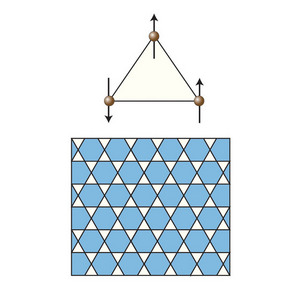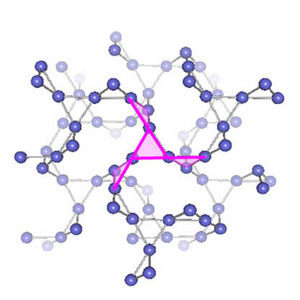Feb. 8, 2008 Research Highlight Chemistry Physics / Astronomy
Exotic material keeps frustrated electrons flipping
Magnetic, temperature and structural studies have yielded new insights on the material sodium iridium oxide
 Figure 1:In the triangular arrangement of iridium atoms in Na4Ir3O8 (top), each electron’s magnetic field will always match one of its neighbors. The pattern of iridium triangles running through the materials lattice matches the traditional Japanese kagome basket (bottom).
Figure 1:In the triangular arrangement of iridium atoms in Na4Ir3O8 (top), each electron’s magnetic field will always match one of its neighbors. The pattern of iridium triangles running through the materials lattice matches the traditional Japanese kagome basket (bottom).
RIKEN scientists have discovered a new state of matter with unusual magnetic properties—its constituent electrons are in a continuous state of flux, even at incredibly cold temperatures.
As electrons spin, they generate a magnetic field which can point ‘up’ or ‘down’. Within solid materials, an electron will generally try to adopt the opposite spin orientation to its neighbor, just as two bar magnets will flip around so that north and south poles line up next to each other.
In more common lattice structures, where atoms stack up like oranges on a greengrocers stall, it’s easy for electrons to achieve this ordered arrangement. But in certain materials, the arrangement of atoms can make it impossible for the electrons to line up with all of their neighbors, and they are said to be ‘frustrated’.
One example of a frustrated material contains a network of atoms arranged into corner-sharing triangles. This is called a kagome structure after a type of Japanese basket that has the same pattern (Fig. 1).
The electrons’ response to this frustration is to constantly flip their magnetic fields to reduce the repulsion between them. In this ‘quantum spin-liquid state’, the quantum effect is expected to stop flipping electrons from freezing out into a static arrangement even at absolute zero (-273.15 ˚C—the coldest temperature possible). Several materials have been claimed to contain possible quantum spin-liquid states, but none have been confirmed.
 Figure 2: An illustration of the hyperkagome lattice.
Figure 2: An illustration of the hyperkagome lattice.
Hidenori Takagi and Yoshihiko Okamoto of RIKEN’s Discovery Research Institute, Wako, and colleagues, have now found that sodium iridium oxide (Na4Ir3O8) exhibits quantum spin-liquid behavior, even when cooled to -271 ˚C. This was confirmed by magnetic, temperature and structural studies, involving both neutron and x-ray diffraction.
The material contains a network of iridium atoms that form a three-dimensional pattern of corner-shared triangles—dubbed a hyperkagome lattice (Fig. 2), which can be viewed as a slightly twisted—but different structure—to the kagome structure, explains Takagi. Theoretical calculations are consistent with this type of structure showing spin-liquid behavior.
“We believe it is the strongest candidate [for a quantum spin liquid],” says Takagi.
The scientists say that the material is “a fascinating playground for quantum magnetism”, and now hope to study the spin-liquid state further. This should to help build up a detailed description of the phenomenon using quantum theory, describing on a subatomic level exactly how the spinning electrons interact with each other.
References
- 1. Okamoto, Y., Nohara, M., Aruga-Katori, H. & Takagi, H. Spin-liquid state in the S = 1/2 hyperkagome antiferromagnet Na4Ir3O8. Physical Review Letters 99, 137207 (2007). doi: 10.1103/PhysRevLett.99.137207
